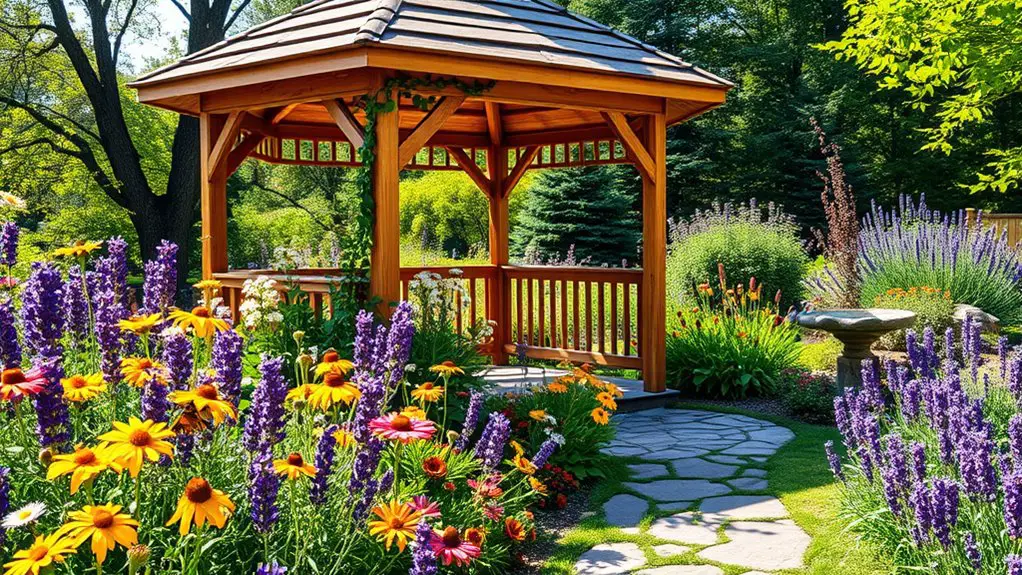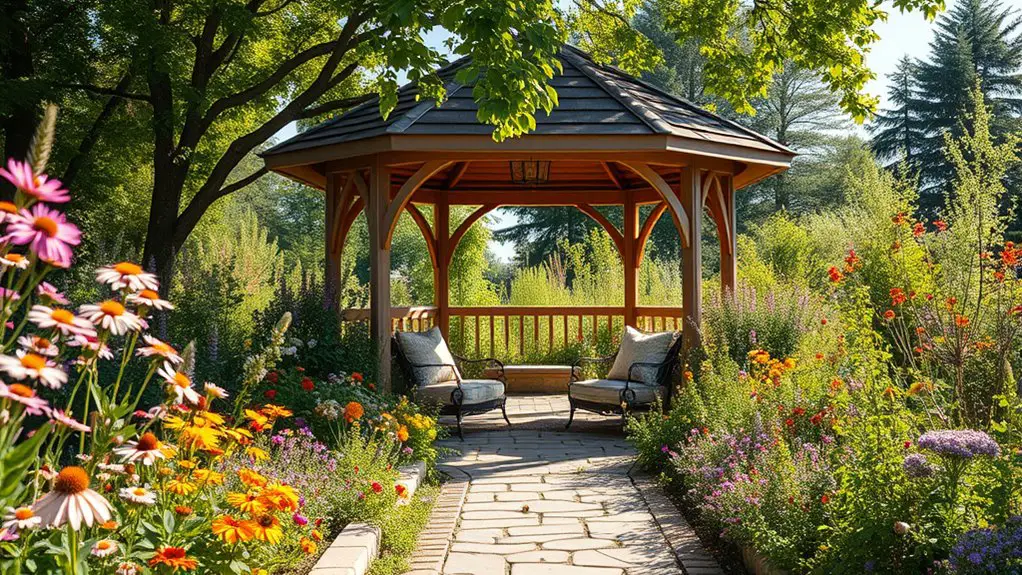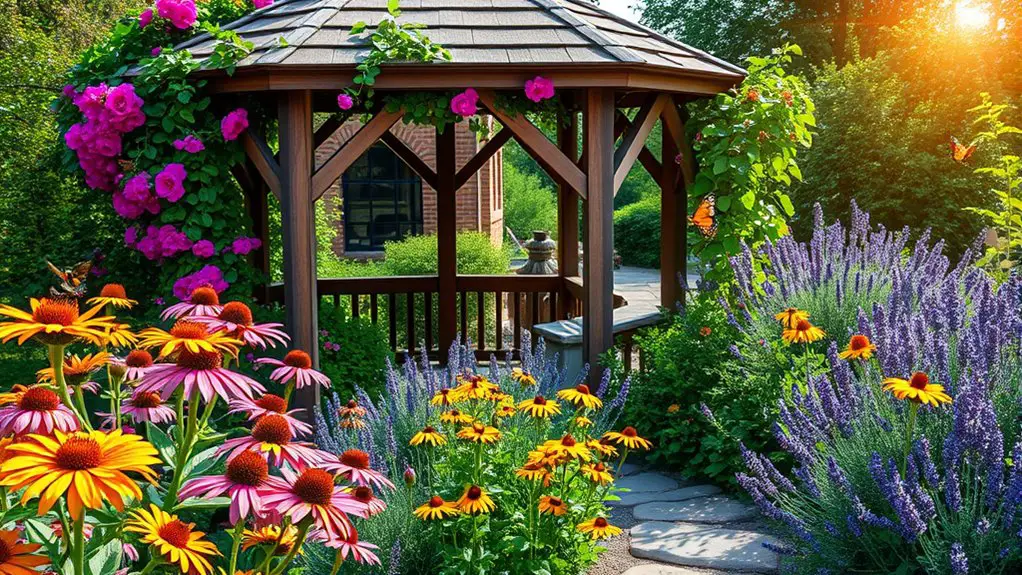Creating a pollinator garden around your gazebo can turn your outdoor space into a vibrant sanctuary. Start by selecting native plants like coneflowers and black-eyed Susans for colorful blooms throughout the seasons. Design your layout with taller plants at the back and shorter ones in front to maximize sunlight. Don’t forget to provide shallow water sources and nesting sites for your buzzing friends. With the right care, your garden will flourish, inviting pollinators and enhancing your retreat in nature. There’s so much more to explore!
Selecting the Right Native Plants

When you’re planning a pollinator garden around your gazebo, choosing the right native plants can make all the difference. Embracing plant diversity is key to attracting a variety of pollinators. Start with flowers like coneflowers and black-eyed Susans, which offer vibrant seasonal blooms to keep your garden lively from spring through fall. These plants not only thrive in your local climate but also provide essential nectar and pollen for bees, butterflies, and hummingbirds.
Don’t forget to mix in some grasses and shrubs, as they create a layered environment that offers shelter and nesting sites. By selecting a range of plants that bloom at different times, you’ll guarantee your garden remains a haven for pollinators all year round. The beauty of native plants lies in their resilience and adaptability, allowing you to cultivate a flourishing ecosystem right at your gazebo, celebrating nature’s freedom to thrive. Additionally, incorporating features like shaded areas can enhance outdoor experiences for pollinators and your family alike.
Designing the Layout of Your Garden
With your selection of native plants in hand, it’s time to focus on designing the layout of your garden to create an inviting space for pollinators. Consider how garden pathways will guide visitors while allowing pollinators easy access to nectar sources. Start by placing taller plants towards the back and shorter ones in the front, ensuring each plant gets adequate sunlight.
Here’s a simple layout to inspire you:
| Plant Type | Height | Placement |
|---|---|---|
| Sunflowers | Tall | Back row |
| Lavender | Medium | Middle row |
| Creeping Thyme | Low | Front row |
Providing Essential Resources for Pollinators

Creating a thriving pollinator garden isn’t just about the plants; it’s also about providing essential resources that cater to the unique needs of these vital creatures. By ensuring your garden offers essential habitats, you’ll attract a diverse range of pollinators. Here are four key resources to include:
- Water Sources: A shallow dish with pebbles helps pollinators hydrate safely.
- Nesting Sites: Leave some bare ground or incorporate bee hotels to provide homes for solitary bees.
- Floral Diversity: Plant a variety of flowering species that bloom at different times for continuous food.
- Pollen and Nectar: Choose native plants rich in nectar and pollen to nourish butterflies and bees alike.
Maintaining Your Pollinator Garden
While a pollinator garden can flourish beautifully on its own, regular maintenance is key to ensuring it remains a haven for these essential creatures. Start by observing your plants through the seasons; each one has unique needs. In spring, clear away debris and check for emerging growth. Summer calls for watering and weeding, but don’t stress—most pollinator-friendly plants are drought-resistant.
Pest management is important; encourage beneficial insects like ladybugs and lacewings, and consider organic methods like neem oil when needed. As the seasons shift, cut back any spent blooms to promote new growth and prepare for a vibrant fall.
In winter, leave some stems standing as shelter for pollinators. Your garden will thrive with a little love and attention, allowing you to enjoy the beauty of nature while nourishing the essential pollinator populations that support our ecosystems.
Enjoying Your Gazebo Retreat in Nature

As you step into your gazebo, the gentle rustle of leaves and the soft hum of bees instantly envelop you, transforming it into a serene retreat. Here, you can savor the beauty of nature while enjoying the ultimate gazebo relaxation. Let the world fade away as you embrace the tranquility around you.
Stepping into your gazebo invites a soothing embrace of nature, a perfect escape for ultimate relaxation and tranquility.
Consider these ways to enhance your experience:
- Meditative Moments: Take a few minutes to breathe deeply and soak in the soothing nature sounds.
- Nature Journaling: Capture your thoughts or sketches inspired by the vibrant pollinators flitting nearby.
- Reading Nook: Bring along a book and lose yourself in a story as the gentle breeze whispers through the trees.
- Mindful Listening: Close your eyes and focus on the symphony of chirping birds, buzzing bees, and rustling leaves.
Your gazebo is your haven, and investing in its features can greatly enhance guest experiences, especially if you consider guest satisfaction as part of your vacation rental strategy. Enjoy every moment!
Frequently Asked Questions
How Can I Attract Specific Pollinator Species to My Garden?
To summon specific pollinators to your garden, you’ll need a vibrant array of native plants with seasonal blooms. Their irresistible allure will have bees, butterflies, and hummingbirds flocking like royalty to your floral kingdom!
What Is the Best Time to Plant My Pollinator Garden?
The best time to plant your pollinator garden is during spring planting, when temperatures warm and soil thaws. Consider seasonal factors like local climate and frost dates to guarantee your flowers thrive and attract pollinators.
Are There Any Plants to Avoid for Attracting Pollinators?
When attracting pollinators, avoid invasive species and toxic plants like oleander or foxglove. They can harm beneficial insects and disrupt your garden’s harmony, so opt for native blooms instead for a thriving, vibrant ecosystem.
How Do I Deal With Pests Without Harming Pollinators?
Dealing with pests without harming pollinators requires natural pest control methods. You can attract beneficial insects like ladybugs and lacewings, which naturally reduce pest populations while keeping your garden healthy and vibrant. Embrace nature’s balance!
Can I Create a Pollinator Garden in a Small Space?
You could transform a tiny balcony into a vibrant pollinator haven using container gardening. Small space design lets you mix colorful flowers like lavender and zinnias, attracting bees and butterflies without needing a large garden.

